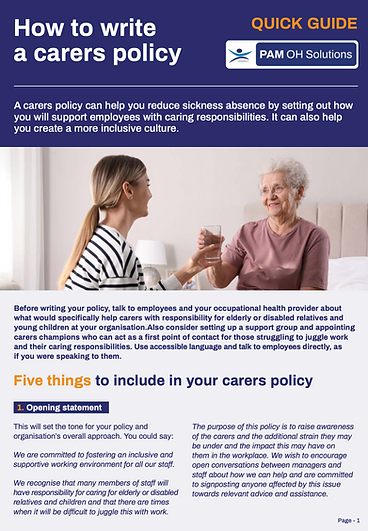
Care more for working carers to reduce sick leave
Despite a quarter of organisations introducing paid carer’s leave, lack of support for the practical and emotional toll of caring is still driving up absence.
Millions of workers across the UK are increasingly struggling with the strain of juggling work with caring for elderly or disabled relatives and children, with one in two employees using sick days to look after loved ones.
In some cases, employees who work as carers are being signed off work as too sick to work. because they’ve become disabled by proxy, meaning they themselves are fit to work, but are unable to do so due to the scale of their caring duties.
For others, the emotional strain of looking after a sick or dying relative, or lack of time to attend their own medical needs, has genuinely made them sick. Fortunately, as our clinical team explains, there are several ways employer can help to keep carers healthy and in work.
Five ways to support carers to stay in work
1. Acknowledge the problem
Despite the Carer’s Leave Act being introduced in 2023, to give carers the right to one week of unpaid leave a year, three quarters (76%) of employers have not raised awareness or providing training to managers about the act. Even though managers have a vital role to play when it comes to providing support to employees.
2. Take stock of the strain being placed on individuals
3. Consider reasonable adjustments
The impact of juggling work and care duties is not to be underestimated, with 40% of carers saying they had to give up work completely. The strain of caring can also make carers sick themselves, with people being referred into Occupational Health due to sickness because they hadn’t had time to get their diabetes prescription due to lack of time caused by caring.
4. Signpost into existing support services
5. Put a formal policy in place to support carers
Free guide to writing a carers policy

How can PAM Group help?
PAM OH Solutions timely access to occupational health professionals who can support the employee to better manage the overall strain being placed on them and identify reasonable adjustments that could be put in place to prevent them from going off sick/quitting.
Workshops & Webinars training for employees on the impact of caring on wellbeing, how to build resilience, still make time for self-care and understand what support their employer has in place. With separate workshops for managers on how best to support carers.
Workforce Planning consultancy service to understand the likely impact of care duties on the ability of employees to attend and perform at work. Plus insight on proactive steps that can be taken to mitigate this and support people to stay in work.
PAM Wellness (EAP) Round-the-clock access to clinical and professional advisors, who can provide emotional counselling and support with childcare, eldercare and other relationship and financial or debt issues.
Related Insights
How to support an employee who has survived cancer
Vaping ban: how to help employees overcome nicotine addiction
How to manage employees with multiple health conditions
Occupational health insights on keeping your people healthy and productive
Want to have our latest research, case studies and opinions
delivered straight to your inbox?





